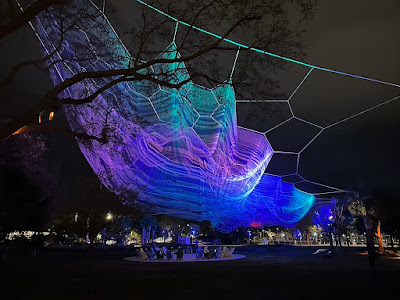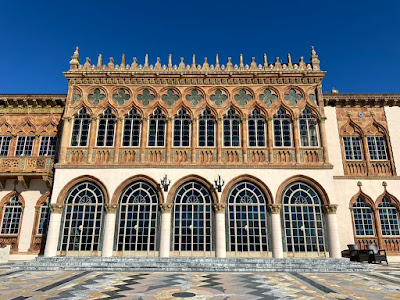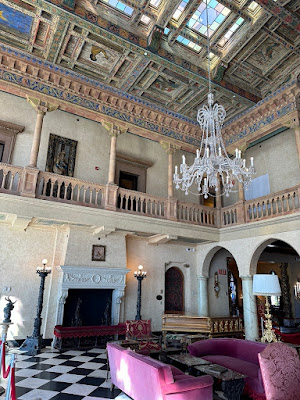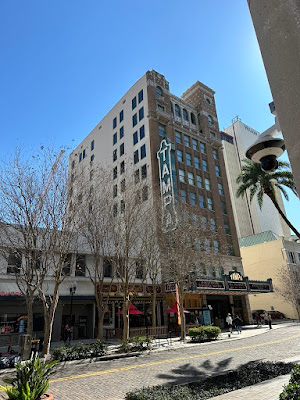In mid February, I made another trip to Florida to visit Diana in St Petersburg. Springtime is usually pretty nice in Florida before the onslaught of the summer heat and humidity, however, this year it was unusually cool and on top of that there was wind and rain.
I paid a couple of trips to the Pas-a-Grille beach while Diana was at work. A nice long shell beach running north-south along the Gulf of Mexico. For me the only reason to visit the beach is to swim, but while there were plenty of people there sunbathing and walking no one was in the water. Except for me. I made a point of going for a dip both times.
 |
| The Don Cesar Hotel |
The highlight of the Pas-a-Grille beach is the magnificent pink hotel, the Don Cesar. Built in the mid 1920's and opened in 1928, the hotel is a thing of great beauty among a sea of less than wonderful construction. In its early days it was a playground for the rich and famous including F Scott Fitzgerald, Al Capone, Lou Gehrig and FDR. It then fell into disuse until the Army bought it and converted it to a hospital in WWII. It has undergone many restorations and now will cost you north of $500 for a room for the night.
 |
| Columbia Restaurant, Ybor City |
Early in my stay we went out to dine at one of the local landmark restaurants, the Columbia in Ybor City. The Columbia claims to be the oldest Spanish restaurant in the USA, being in operation since 1903. The building exterior is quite beautiful and the interior is equally beautiful, provided you like colorful tile work. The food was OK but not exceptional.
 |
| Bending Arc by Janet Echelman |
Near the pier in St Petersburg is an art installation of netting strung from poles, the Bending Arc. In the daytime it is nice but it really turns into something special when illuminated at night.
 |
| Sponge Boat in Tarpon Springs |
When Diana started her days off and when the weather stopped raining, we drove up the coast to Tarpon Springs. This is a coastal community that is the center of the sponge fishing industry. Apparently the town was first populated by Greek immigrants that had experience in diving for sponges back in their homeland of Greece. Sponge Diving and the Greek heritage are now a major part of the tourist industry of Tarpon Springs. There are many Greek flags and many opportunities to eat Greek food.
The next day we headed south from St Petersburg to Sarasota. Sarasota became the winter home of John Ringling, the circus magnate. He built an impressive home and art museum there and they have now added a circus museum to the grounds. Normally a circus museum would not be high on my list of things to visit and when I got inside and found out that the museum was primarily a model of a circus I was even less enthused. However, it turned out to be really quite interesting and it opened my eyes to a form of early 20th century American entertainment that I was not particularly aware of.
Circuses were very popular in the late 1800's and early 1900's. There wasn't a lot of entertainment in the pre-TV and pre-movie days and so circuses provided one of the only entertainment options available. They became a major operation with three rings inside a huge tent. Ringling and Barnum and Bailey grew into significant operations and they eventually merged into one company. At it's height there were some 1500 employees traveling along with animals, acts and equipment. They had a 60 carriage train that moved everything overnight into the next town where they would offload everything, feed everyone, including the animals, and perform a couple of shows before packing it all up and moving on to the next town where they repeated the whole process again. What an amazing logistical exercise.
 |
| The model of the Ringling Brothers Circus |
The model of the circus in the museum was the life's work of one Howard Tibbals. It is a complete replica of the entire circus as it would appear in the 1920's. It is built to a 1/4in to 1 foot scale with the train, the big top, with three rings inside, all the animals, the performers, the audience, the canteen, everything. I was totally surprised at how fascinating it was.
 |
| Human Cannonball |
The other parts of the museum had less impressive exhibits - a canon for the human cannonball, Mr Ringling's private railcar, a steam organ, and a tightrope width rail to test your balance - I failed miserably.
 |
| Banyan Trees |
The museum is in the same grounds as the Ringling House and the Art Museum. There was a lake, a rose garden, the Ringling's family graves, and lots of wonderful Banyan trees with their many vertical limbs draping down to the ground where they take root and presumably provide stability and food to the tree.
 |
| Ca d'Zan (rear facing the sea) |
The Ringling mansion was designed and built in the 1920's. It's design exhibits elements of the Italian Renaissance and Venetian Gothic architecture, both favorite styles of John Ringling. It is referred to as the Ca d'Zan, which apparently translates to the "House of John" in the Venetian dialect. Ringling and his wife traveled extensively in Europe as did many wealthy Americans of that time. They were quite wealthy and as they toured they purchased all manner of furnishings and art to decorate their new home, just like Citizen Kane and William Randolph Hearst.
 |
| Interior of Ca d'Zan |
The garden and the house are located on the edge of Sarasota Bay so it is a beautiful setting. Sarasota became the circus's winter home when cold weather prevented circus shows in the northern states. Life must have been quite nice there during the first half of the 20th century. It is still pretty nice today, though the surrounding area is now built up with high rise condominiums.
 |
| The Ringling Museum of Art |
Mr Ringling and his wife also built an art museum adjacent to the house and today this houses an impressive art collection. Much of it was purchased by Mr Ringling but there have been many subsequent additions to the collection. It is an impressive building enclosing a central quadrangle with lawns, trees, fountains and sculptures.
 |
| The Ringling Museum of Art |
There was a nice combination of old pieces from Mr Ringling's collection (a couple of Canaletto's too) and modern pieces too. A delightful art museum that is well worth a visit.
 |
| The Tampa Theatre |
The following day we paid a visit to Tampa. The first thing on our list was a tour of the Tampa Theatre. This 1920's picture house is a wonderful example of what was then referred to as an atmospheric theatre, a theatre where the interior was so exotic and wonderful that a visit to the theatre would have been more than just watching a movie. The theatre opened in 1926 and it was the first commercial building in Florida to offer air conditioning, another reason it would have been a great experience to pay a visit. Apparently you could stay all afternoon or evening with the price of a single ticket.
 |
| Tampa Theatre Stage |
We had signed up for the theatre tour. The guide took us around all parts of the theatre (including back stage) and told us all the stories of what a wonderful experience it must have been to visit the theatre in its heyday.
 |
| The Wurlitzer Organ |
The tour finished off the tour with a recital on the Wurlitzer organ. They cranked up the air pumps backstage and raised up the organ from below the stage and we had a little education on Wurlitzer theater organs. Of course, no organ recital in USA could omit the old classic "Take me out to the ball game..." and ours was no exception.
 |
| The Hillsborough River, Tampa |
After the theatre tour we walked down to the Hillsborough river and over to the west side and the grounds of the University of Tampa. Walking along the river by the University was all very idyllic. Students were lounging on the lawn or lying in hammocks. Many females were sunbathing in bikinis. All very distracting for the male students I am sure.
 |
| The Tampa Hotel and Plant Museum |
The University occupies part of the old Tampa Bay Hotel. This majestic old hotel was built in the late 1800's by the railroad and shipping magnate, Henry Plant. The design of the hotel is quite exotic - there are towers, cupolas and minarets. It certainly looks very distinctive among the remainder of modern buildings in the city.
 |
| The Mens Reading Room, the Tampa Hotel |
Part of the hotel, the part not occupied by the University, is now a museum, the Henry Plant Museum. The museum depicts how fine the hotel was in its glory days. It was one of the first all electric buildings in Florida. There was electricity and telephones in all rooms and most rooms had private baths
During the Spanish American War many of the old veteran soldiers stayed in the hotel, including Teddy Roosevelt, and they used to relax on the veranda in rocking chairs while they were waiting for the action to begin (it took a while). This gave the name "Rocking Chair War" to the conflict.
 |
| The Newman Cigar Factory |
The next day we went back to Tampa again. This time to tour the Cigar Factory in Ybor City. During the late 1800's and early 1900's there were a lot of cigar factories in Tampa, particularly in the Ybor area. The cigars in those days were all hand rolled mostly by Cuban immigrants. However, today only one cigar factory survives, the J.C. Newman Cigar Factory.
 |
| Cigar Manufacturing |
We signed up for the tour and had a great education in the various processes of the cigar making business. While initially the cigars would all be hand-rolled the process was automated in the mid-1900's. The machines are still in use today but they are no longer being built. With so many moving parts, I am sure it is a demanding process to keep them working continuously. Interestingly, the machines were actually made by the AMF Company, the maker of 10 Pin Bowling machines.
 |
| Cigar Storage |
We were shown through the basement where the cigars are aged, and where the raw tobacco is stored until it is ready to be processed.
 |
| Stripping the tobacco leaf veins |
Then we moved up to the main factory level where machines strip the veins from the tobacco leaves (by women who are called strippers), and where the cigar machines turn out a nice cigar every few seconds. There are three components to the cigar - the filler which is smaller irregular pieces of tobacco leaf, the binder, a paper and tobacco composite sheet that binds the filler together, and a wrapper leaf, a finer quality leaf that gives the cigar its smooth outer edge.
 |
| The Hand Rolling Room |
We then went further upstairs to the hand rolling room. Here there were around 10 workers rolling cigars by hand. This once was a much larger room with literally hundreds of workers. Now it is much reduced but there is still the stage present where a reader would be employed to read stories and news articles to the workers as the continued to roll cigars.
It was all very educational but I wasn't tempted to buy any cigars and take up the habit. We left the cigar factory and walked over to the nearby La Segunda Bakery. This is one of the old bakeries in the area that is well known for baking Cuban bread. We had a fine Cuban sandwich and a Muffaletta sandwich for lunch.
 |
| Jose Marti Park |
We then paid a visit to the Jose Marti Park. This is a little plot of land in Ybor city that is owned by the people of Cuba. It is the site of the house where Jose Marti, the Cuban National Hero was nursed back to health after being poisoned in 1892. When the house was demolished in the 1950's the land was donated to the people of Cuba. Until the Embassy in Washington opened in 2015 it was the only Cuban owned land in the USA.
 |
| Jose Marti Park |
In the park, there is a map of Cuba and a statue of Marti and there are a lot of chickens and roosters wandering around, as there are in many places in Tampa.
 |
| Hindu Temple |
 |
| Ornamentation on the Temple |
A little ways out of town there is a modern new and quite large Hindu temple. Since this is not typically what you find in an American city we went to have a look. It was quite a beautiful temple with some wonderfully detailed ornamentation. We couldn't go in but from the outside it was well worth the visit.
 |
| A piece of the Berlin Wall |
On the next day, my last, we managed to squeeze in one more thing - a quick look at a section of the Berlin Wall in St Petersburg. It stands outside an old station that is now a pottery and clay arts center. Not the most dramatic of sights but still, a piece of history from a distant land and a bygone time.



